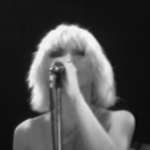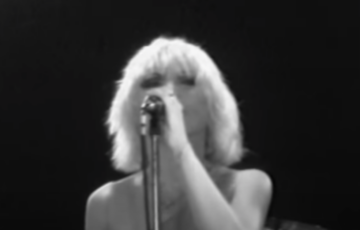[Most Recent Entries] [Calendar View]
Tuesday, July 13th, 2021
| Time | Event |
| 8:00a | Watch Blondie Perform a Classic Concert During The Breakout Year: “Dreamin,” “One Way Or Another,” “Heart of Glass” & More (1979)   When Blondie took the stage at Convention Hall in Asbury Park, NJ in 1979, the audience knew the band as a vehicle for former Playboy bunny-turned-punk-singer Debbie Harry. “Debbie put on that sexy persona with kind of a wink, saying ‘This is what you want from me, I’ll kind of give it to you, but I’m also going to give you what I want to give you,’’” says biographer Cathay Che. “The Blondie character,” as Harry called her onstage persona, “embodied female sexuality as part threat, part unattainable goal, part parody,” as Ann Powers writes at The New York Times. Cast in the role of sexualized object since her early teen years, she had also performed in bands since the late 60s, and had survived sexual assault and a near abduction in New York City in the 70s. She was a world-weary performer in control of her image, but the character drew so much focus from Blondie the band that other members got a bit defensive. “I remember the tour Blondie was doing in April 1978,” punk photographer Theresa Kereakes writes:
Blondie was most definitely a group. By 1979, they had grown into a formidable six-piece, adding guitarist Frank Infante and bassist Nigel Harrison to the original lineup of Harry, Chris Stein, Jimmy Destri, and Clem Burke. On the cusp of major mainstream success, they had also hit a peak in terms of musicianship and songwriting — powerhouse drummer Burke holding the machinery together while each member played a vital part. The focus on Harry didn’t only detract from her male band members. “Ms. Harry must have felt a bit like… the object of someone else’s profitable fantasy” at times,” writes Powers, trapped in the role of punk-rock Marilyn Monroe. As keyboard player Destri put it, “no one really paid attention to Debbie’s singing style and how great a writer she was, because they couldn’t get past the image,” They would pay attention after Parallel Lines and follow-ups Eat to the Beat and Autoamerican. Songs like “Dreaming,” revamped disco hit “Heart of Glass,” and dancefloor classics “Call Me” and “Rapture” made Harry an international superstar and left the rest of the band disenchanted. Before lawsuits and longstanding resentments broke them up, Blondie was an incredible live band. See them prove it in the full show at the top, the first set of the night. They played a second, duplicate set later, adding Marc Bolan’s “Bang a Gong” at the end of the night. See them tear through it just above and see a full setlist with timestamps on YouTube. Related Content: How Blondie’s Debbie Harry Learned to Deal With Superficial, Demeaning Interviewers Blondie Plays CBGB in the Mid-70s in Two Vintage Clips Josh Jones is a writer and musician based in Durham, NC. Follow him at @jdmagness Watch Blondie Perform a Classic Concert During The Breakout Year: “Dreamin,” “One Way Or Another,” “Heart of Glass” & More (1979) is a post from: Open Culture. Follow us on Facebook and Twitter, or get our Daily Email. And don't miss our big collections of Free Online Courses, Free Online Movies, Free eBooks, Free Audio Books, Free Foreign Language Lessons, and MOOCs. |
| 11:00a | An Introduction to Nicolas Bourbaki, One of the Most Influential Mathematicians of All Time … Who Never Actually Lived   In 20th-century mathematics, the renowned name of Nicolas Bourbaki stands alone in its class — the class, that is, of renowned mathematical names that don’t actually belong to real people. Bourbaki refers not to a mathematician, but to mathematicians; a whole secret society of them, in fact, who made their name by collectively composing Elements of Mathematic. Not, mind you, Elements of Mathematics: “Bourbaki’s Elements of Mathematic — a series of textbooks and programmatic writings first appearing in 1939—pointedly omitted the ‘s’ from the end of ‘Mathematics,'” writes JSTOR Daily’s Michael Barany, “as a way of insisting on the fundamental unity and coherence of a dizzyingly variegated field.” That’s merely the tip of Bourbaki’s iceberg of eccentricities. Formed in 1934 “by alumni of the École normale supérieure, a storied training ground for French academic and political elites,” this group of high-powered mathematical minds set about rectifying their country’s loss of nearly an entire generation of mathematicians in the First World War. (While Germany had kept its brightest students and scientists out of battle, the French commitment to égalité could permit no such favoritism.) It was the pressing need for revised and updated textbooks that spurred the members of Bourbaki to their collaboratively pseudonymous, individually anonymous work. “Yet instead of writing textbooks,” explains Quanta‘s Kevin Hartnett, “they ended up creating something completely novel: free-standing books that explained advanced mathematics without reference to any outside sources.” The most distinctive feature of this already unusual project “was the writing style: rigorous, formal and stripped to the logical studs. The books spelled out mathematical theorems from the ground up without skipping any steps — exhibiting an unusual degree of thoroughness among mathematicians.” Not that Bourbaki lacked playfulness: “In fanciful and pun-filled narratives shared among one another and alluded to in outward-facing writing,” adds Barany, “Bourbaki’s collaborators embedded him in an elaborate mathematical-political universe filled with the abstruse terminology and concepts of modern theories.” You can get an animated introduction to Bourbaki, which survives even today as a still-prestigious and at least nominally secret mathematical society, in the TED-Ed lesson above. In the decades after the group’s founding, writes lesson author Pratik Aghor, “Bourrbaki’s publications became standard references, and the group’s members took their prank as seriously as their work.” Their commitment to the front was total: “they sent telegrams in Bourbaki’s name, announced his daughter’s wedding, and publicly insulted anyone who doubted his existence. In 1968, when they could no longer maintain the ruse, the group ended their joke the only way they could: they printed Bourbaki’s obituary, complete with mathematical puns.” And if you laugh at the mathematical pun with which Aghor ends the lesson, you may carry a bit of Bourbaki’s spirit within yourself as well. Related Content: Beautiful Equations: Documentary Explores the Beauty of Einstein & Newton’s Great Equations The Mathematics Behind Origami, the Ancient Japanese Art of Paper Folding The Unexpected Math Behind Van Gogh’s Starry Night Can You Solve These Animated Brain Teasers from TED-Ed? The Map of Mathematics: Animation Shows How All the Different Fields in Math Fit Together Why the World’s Best Mathematicians Are Hoarding Japanese Chalk Based in Seoul, Colin Marshall writes and broadcasts on cities, language, and culture. His projects include the Substack newsletter Books on Cities, the book The Stateless City: a Walk through 21st-Century Los Angeles and the video series The City in Cinema. Follow him on Twitter at @colinmarshall or on Facebook. An Introduction to Nicolas Bourbaki, One of the Most Influential Mathematicians of All Time … Who Never Actually Lived is a post from: Open Culture. Follow us on Facebook and Twitter, or get our Daily Email. And don't miss our big collections of Free Online Courses, Free Online Movies, Free eBooks, Free Audio Books, Free Foreign Language Lessons, and MOOCs. |
| 2:00p | What the Eagles’ “Hotel California” Really Means   During the Satanic panic of the 1980s, a new breed of witchfinder cast a dragnet through pop culture, scooping up songs, artists, and albums that were allegedly part of a demonic conspiracy to corrupt America’s youth. One song routinely appearing on such lists — “Hotel California” by the Eagles. Really? The Eagles? Biggest-selling rock band in the U.S.? Soft-rock superstars who paved the cocaine-colored way for even softer yacht rock superstars? They were hardly Black Sabbath, but the band’s “Hotel California” was really about Anton LaVey’s Church of Satan, it was said (just listen to it backwards). Depending on your feelings about Satanism and/or the Eagles, “the truth proves far less satisfying than the myriad rumors that have sprung up,” writes David Mikkelson at Snopes. “The song is usually interpreted as an allegory about hedonism and greed in Southern California in the 1970s.” It turned out to be a self-fulfilling prophecy. Hotel California, the album, rocketed the Eagles beyond “success on a frightening level” and into total burnout. By the time they made their last album of the 70s, The Long Run, they felt trapped in a celebrity hell, one that would have to freeze over before they reunited, as Don Henley remarked (hence the title of 1994’s Hell Freezes Over). For the Eagles, hell was the other people in the band, the constant touring, and the incredible amounts of money thrown their way, more curse than blessing, apparently. Despite these internal tensions, the Eagles produced a perfect soundtrack for the 70s. “They reflected the emerging musical style of a 70s post-war America, and the first truly sexually liberated generation…. had no trouble identifying with a band that sang like angels and partied like devils,” writes Marc Eliot. “Hotel California” has been so closely identified with American culture that “when a US spy plane made an emergency landing in China in 2001,” Mark Savage notes at the BBC, “the crew members were asked to recite the lyrics to prove their nationality.” In truth, “Hotel California” is neither written in praise of Satan nor America. Its working title was “Mexican Reggae,” a nod to the unusual strumming pattern, which “followed a pattern closer to flamenco than to rock,” Savage writes, “but played on the off-beat.” The forbidding landscape in the song’s lyrics, an “atmosphere of a man in an unfamiliar rural setting, unsure about what he’s witnessing,” came from the 1965 novel The Magus by English author John Fowles, a countercultural favorite, says Glen Frey: “We decided to create something strange, just to see if we could do it.” There was, of course, more to the song — the standard interpretation of “Hotel California” as a critique of 1970s excesses has been affirmed by Don Henley and Frey, who wrote most of the lyrics. The song, Henley said in a 1995 interview, “sort of captured the zeitgeist of the time, which was a time of great excess in this country and in the music business in particular…. Lyrically, the song deals with traditional or classical themes of conflict: darkness and light, good and evil, youth and age, the spiritual versus the secular. I guess you could say it’s a song about loss of innocence” — a feeling, as Joe Walsh says in the interview clip above, that came out of the experience of arriving and trying to make it in L.A. “Nobody was from California,” Walsh says. “Everybody was from Ohio.” “Hotel California” also “hides” a dig at Eagles rivals Steely Dan in the lyrics, “they stab it with their steely knives” and barely conceals Henley’s contempt for his ex-girlfriend, L.A. jewelry designer Loree Rodkin, as he later admitted: “There’s some of every girl I’ve ever been with in all my songs; they’re combinations of characters, like fiction. Some of the more derogatory parts of ‘Hotel California,’ however, are definitely about Loree Rodkin – ‘Her mind is Tiffany twisted, she got the Mercedes bends/She got a lot of pretty boys that she calls friends’ – that’s about her, and I wouldn’t be crowing if I were Ms. Rodkin. As far as I’m concerned, she’s the Norma Desmond of her generation.” Henley’s most trenchant commentary on the song comes from the 2013 documentary History of the Eagles, in which he talks frankly about the band’s critical take on their success and the culture that produced and embraced “Hotel California”:
As for those baroque guitar arrangements? For that part of the story, we must turn to Don Felder, who composed the song — after Walsh joined the band to replace Bernie Leadon — in order to showcase the talents of two lead players. See Felder talk about his major contribution at the top and see him play the “Hotel California” solo at the Metropolitan Museum of Art in a clip from CBS’s Sunday Morning. Just above, see an interview with Felder backstage at the Rock and Roll Hall of Fame, in which he discusses the role of improvisation in his process, and how his background in jazz led him to write the “Mexican reggae” that would eventually play on American radio every 11 minutes, their most refined statement of the “themes that run through all our work,” Henley says: “loss of innocence, the cost of naiveté, the perils of fame, of excess; exploration of the dark underbelly of the American dream, idealism realized and idealism thwarted, illusion versus reality, the difficulties of balancing loving relationships and work, trying to square the conflicting relationship between business and art; the corruption in politics, the fading away of the Sixties dream of ‘peace, love and understanding.’” Related Content: Josh Jones is a writer and musician based in Durham, NC. Follow him at @jdmagness What the Eagles’ “Hotel California” Really Means is a post from: Open Culture. Follow us on Facebook and Twitter, or get our Daily Email. And don't miss our big collections of Free Online Courses, Free Online Movies, Free eBooks, Free Audio Books, Free Foreign Language Lessons, and MOOCs. |
| << Previous Day |
2021/07/13 [Calendar] |
Next Day >> |






